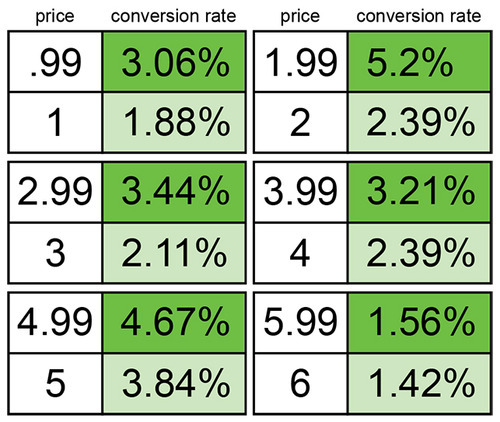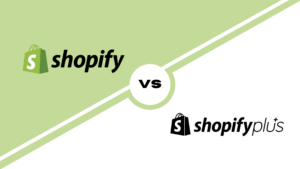The ideal price point, decided based on testing using multiple pricing hacks, is an important factor that decides your product’s conversion rate.
A combination of the right pricing, along with a product-market fit sets the foundation for being able to add value to the market and hence, drive conversions and revenue from it.
I have explained the best Conversion Rate Optimization hacks in detail in the post titled ‘Ecommerce CRO: Growth Hacks to Improve Your Ecommerce Conversion Rate Today’ and in this post, I’m going to share the top price point hacks with you.
No matter how many hacks you execute on your website or product pages for improving conversion rates, you’ll have to ensure you’re using a “price point that converts” too.
So try out the following pricing hacks in your eCommerce, SaaS, product business and measure the results.
Pricing Hack 1: Reduce the left-most digit using prices ending in 9
Consider 2 price points: $3 vs $2.99.
The perceived value of $3 would be less because people decide the magnitude of the price based on the left-most digit first.
While you will often see prices ending in 9, remember that ending a price with 9 itself may not be effective unless the left digit changes.
So while $50 may be perceived as higher than $49 or $49.99, even $49.98 would be perceived as lesser than $50 as $50 becomes the reference point for consideration.

The recommended hack here is to make sure you have a lower-magnitude left-most digit while ensuring the real difference in your ideal price and the shown price isn’t actually much.
Pricing Hack 2: Sort products by their pricing in descending order
Showing higher prices first serve as a reference point for users to have something to compare to as they scroll down your product catalog.
As the user browses through the page, they are more likely to make a buying decision once they see lower-priced products.
Pricing Hack 3: How to show a comparison price to improve conversions
It is common for websites and eCommerce stores to show a “was the price” or “before price” on product pages.
Some SaaS businesses also show price comparisons between products.
So while showing price comparisons between 2 products, use this hack to get more purchases on a favorable outcome:
Even if 2 products are closely prices, showcasing the favorable product priced at $2.99 will get more conversions compared to, say, a $4 product. This is because users perceive the difference between $4 and $2.99 as of close to 2.
Adding a higher-priced product for comparison also improves the conversion rate of the lower-priced product.
Another way to use this will be to show $4 as a “was the price” on a $2.99 “now price” product.
You can, of course, go higher with the difference between the before and now price but I usually recommend keeping it less than a 50% difference for an eCommerce business to avoid affecting your branding.

If you’re using Shopify to run an eCommerce store, you can set the compare price quite easily with the default option on the product settings itself.
Product pages for SaaS businesses can experiment in a much wider range of was and now prices.
That being said, I would personally bounce off a product page offering a product originally priced at $999 at $9 only!
Pricing Hack 4: Show prices in smaller font size on the website
Psychological user-behavior research shows that users perceive product prices displayed in smaller fonts to be lesser.
Just reduce the price font size by a small percentage compared to the regular font size on the rest of the content on your web page.
If you have a was price or before the price for comparison, only reduce the font size of the smaller price and not the before price.
Pricing Hack 5: Get rid of the comma in your prices
The concept to remember is that for higher prices, $1200 would work better than $1,200.
This also comes from psychology as users consider visually and phonetically longer prices as higher.
Pricing Hack 6: Add low-magnitude keywords in the pricing
While showcasing product features in the listing, saying “a small $4.99 fee” would work better than saying “a $4.99 fee”.
Low-magnitude keywords affect the user perspective of the said price point.
Pricing Hack 7: Use a lower price point for product bundles
Showcase product bundles to show a better deal and improve average order value.
Users perceive discounted bundles as higher value at a lower cost.
When you showcase a product bundle, make sure all the products in the bundle are shown to be offered at a discounted price each when compared to buying them individually.
This adds different levels of perceived discounts rather than just the single bundle discount – even though in execution, the discount will only be on the overall product bundle.
Pricing Hack 8: Add the word ‘SALE’ with the pricing on discounted products
Simply adding the word ‘SALE’ next to the pricing has higher conversion rates than just showcasing the lower price.
Adding the price for comparison along with the word SALE has the best overall performance for conversions.
For example:
was $150 $99 SALE
Further, the was price can be shown in a larger font compared to the SALE price.
Pricing Hack 9: Make your free shipping threshold price based on your target AOV
Keep your free shipping threshold close to your target ticket size.
You can showcase free shipping bundles on low-cost products that are below the shipping threshold.
While deciding product prices, always modify or pick your product prices keeping the free shipping threshold in mind.
Pricing Hack 10: Offer payments in installments to affect price comparison
4 installments of $49 can perform better than one payment of $200 especially if your competitors don’t offer installments.
As per user psychology research, users tend to compare your single installment price point (i.e $49) to the total price point of competitors (i.e $200).
Execute these pricing hacks for your product startup, eCommerce store, or SaaS business and see how it goes.
I’ve also created a video course on ‘Price Point Hacking’. Get the complete video course on Pricing Hacks here.

Topics covered in the Pricing Hacks course:
Here’s what you’ll LEARN:
- Most Effective Psychological Research-Based Pricing Hacks
- Improve Conversions and sell more immediately
- Simple and effective pricing hacks you can execute right away
- Improve conversion rates, average order value, boost product subscribers
- For eCommerce stores, digital products, SaaS businesses, and startups
- BOOST your revenue by improving conversions through easy pricing hacks
The course is free if you have a SkillShare account. Alternatively, you can sign up here and get 2 months of free access and take the course right away.
All the best!



